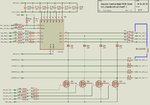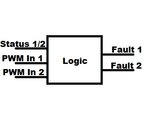dhruv_electro
Advanced Member level 4
Hi,
As shown in attachment we are using BTS716G for Solenoid driver. In our design there are 16 solenoid.
The block attached here shows driver for 4 solenoid, other block are ideal to this.

Now our question is how we can detect the Open load error or Over temperature error from a single signal for two channels.
We have seen the Truth table given in datasheet but, we are confuse at how we can detect the error.
Suppose from 16 solenoid if we are going to use on 13 channel then there may be :
1. Channel 1-12 are used identically.
2. Channel 13 is used but its sibling pair Channel 14 is left open always
3. Channel 15 and 16 is also left open always
Now what if channel 13 gets over temperature in field, how can we detect that from Status signal.
What will happen when one channel of two sibling channel pair, is over temperature and other channel is open load?
Please suggest us the logic so we can detect the error in Microcontroller.
Truth table for BTS716G internal logic given in datasheet:

Datasheet for **broken link removed**
As shown in attachment we are using BTS716G for Solenoid driver. In our design there are 16 solenoid.
The block attached here shows driver for 4 solenoid, other block are ideal to this.

Now our question is how we can detect the Open load error or Over temperature error from a single signal for two channels.
We have seen the Truth table given in datasheet but, we are confuse at how we can detect the error.
Suppose from 16 solenoid if we are going to use on 13 channel then there may be :
1. Channel 1-12 are used identically.
2. Channel 13 is used but its sibling pair Channel 14 is left open always
3. Channel 15 and 16 is also left open always
Now what if channel 13 gets over temperature in field, how can we detect that from Status signal.
What will happen when one channel of two sibling channel pair, is over temperature and other channel is open load?
Please suggest us the logic so we can detect the error in Microcontroller.
Truth table for BTS716G internal logic given in datasheet:

Datasheet for **broken link removed**




